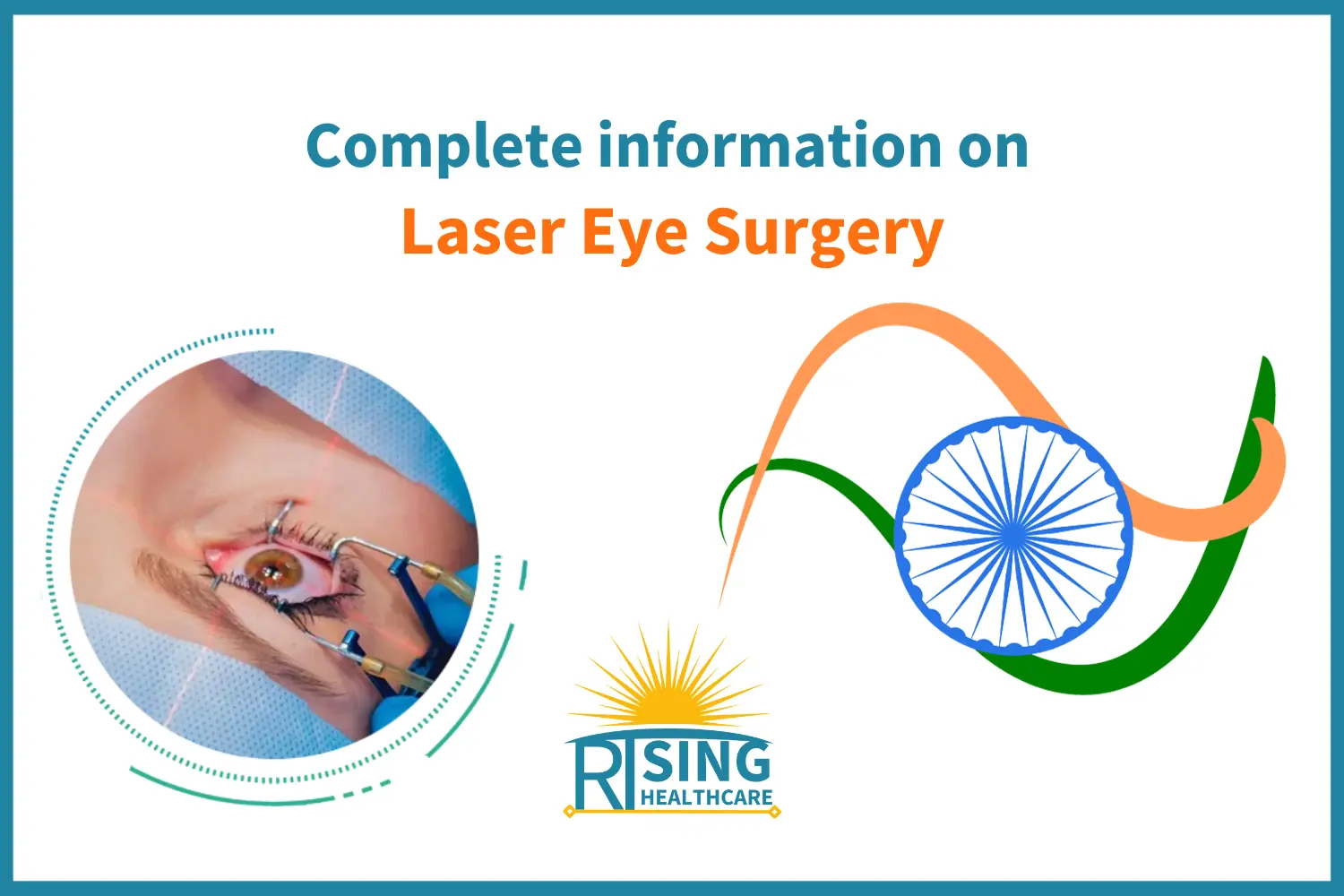
A Clearer Vision: Understanding Laser Eye Surgery
Introduction
Imagine a world without the need for glasses or contact lenses. A world where you wake up in the morning and can see the world around you with perfect clarity. Thanks to advances in medical technology, this dream is becoming a reality for many people through a procedure known as laser eye surgery. In this article, we will explore laser treatment for eyes, different types of eye surgery, and focus on one of the most innovative techniques, Femto LASIK, in simple language.
Contents
- 1 Laser Treatment for Eyes
- 1.1 What is Laser Eye Surgery?
- 1.2 How Does Laser Eye Surgery Work?
- 1.3 Who is a Suitable Candidate for Laser Eye Surgery?
- 1.4 1. LASIK (Laser-Assisted In Situ Keratomileusis)
- 1.5 2. PRK (Photorefractive Keratectomy)
- 1.6 3. LASEK (Laser Epithelial Keratomileusis)
- 1.7 4. SMILE (Small Incision Lenticule Extraction)
- 1.8 5. Epi-LASIK (Epithelial Laser-Assisted In Situ Keratomileusis)
- 1.9 Femto LASIK - A Modern Advancement
- 1.10 What is Femto LASIK?
- 1.11 Advantages of Femto LASIK
- 1.12 Is Femto LASIK Right for You?
- 1.13 The Laser Eye Surgery Experience
- 1.14 Preparing for Surgery
- 1.15 The Day of Surgery
- 1.16 Recovery
- 1.17 Results
- 1.18 Potential Risks and Complications
- 1.19 Conclusion
Laser Treatment for Eyes
What is Laser Eye Surgery?
Laser eye surgery, also known as refractive eye surgery, is a medical procedure designed to correct common vision problems such as nearsightedness (myopia), farsightedness (hyperopia), and astigmatism. The primary goal of laser eye surgery is to reduce or eliminate a person’s dependence on glasses or contact lenses, providing them with improved vision.
How Does Laser Eye Surgery Work?
Laser eye surgery works by reshaping the cornea, which is the clear front part of the eye responsible for focusing light onto the retina. An excimer laser, an advanced and precise type of laser, is used in these procedures.
Here’s a simplified breakdown of the process:
- Anesthetic Drops: Before the surgery, anesthetic eye drops are applied to ensure the patient feels no pain during the procedure.
- Creating a Flap: In some laser eye surgeries like LASIK, a thin flap is created on the cornea’s surface using a microkeratome (a small surgical instrument) or a femtosecond laser (more on this later).
- Laser Reshaping: The excimer laser is then used to precisely remove a small amount of corneal tissue to reshape it. This reshaping allows light to be correctly focused onto the retina.
- Flap Replacement: If a flap was created, it is carefully repositioned, and no stitches are usually needed.
- Recovery: After the surgery, patients are given time to recover, and their eyes are monitored to ensure they heal properly.
Who is a Suitable Candidate for Laser Eye Surgery?
Laser eye surgery isn’t for everyone, and whether you’re a suitable candidate depends on various factors, including your eye health, age, and the stability of your vision prescription. A comprehensive eye examination by an ophthalmologist or optometrist will help determine if you’re a good candidate for the procedure.
Eye Surgery Types
Laser eye surgery is not a one-size-fits-all solution. There are several different types of eye surgery, each tailored to address specific vision issues. Here are some of the most common types:
1. LASIK (Laser-Assisted In Situ Keratomileusis)
LASIK is perhaps the most well-known type of laser eye surgery. It is used to correct nearsightedness, farsightedness, and astigmatism. During LASIK, a small flap is created on the cornea’s surface using either a microkeratome or a femtosecond laser. The excimer laser then reshapes the underlying corneal tissue to improve vision.
LASIK is known for its rapid recovery time, with many patients experiencing improved vision within a day or two. It is important to note that LASIK is not reversible.
2. PRK (Photorefractive Keratectomy)
PRK is another type of laser eye surgery that reshapes the cornea to correct vision problems. Unlike LASIK, PRK does not involve creating a corneal flap. Instead, the surgeon removes the outer layer of the cornea (the epithelium) before using the excimer laser to reshape the underlying tissue.
While PRK has a longer recovery period compared to LASIK, it is a suitable option for individuals with thin corneas or those who may not be eligible for LASIK for other reasons.
3. LASEK (Laser Epithelial Keratomileusis)
LASEK is a hybrid of LASIK and PRK. It involves creating a flap on the cornea’s epithelial layer, similar to LASIK, but then the epithelial layer is treated with alcohol to make it easier to lift. After lifting the flap, the excimer laser reshapes the cornea.
LASEK may be recommended for people with thinner corneas or those at higher risk of developing dry eyes after LASIK.
4. SMILE (Small Incision Lenticule Extraction)
SMILE is a relatively new and minimally invasive laser eye surgery technique. It is used to treat myopia (nearsightedness). During SMILE, a femtosecond laser is used to create a small, disc-shaped piece of tissue within the cornea, called a lenticule. This lenticule is then removed through a small incision, which reshapes the cornea and corrects the vision.
One of the advantages of SMILE is its potential for faster recovery and less discomfort compared to some other procedures.
5. Epi-LASIK (Epithelial Laser-Assisted In Situ Keratomileusis)
Epi-LASIK is a variation of LASIK where a special separator is used to gently lift and preserve the corneal epithelial layer. The excimer laser is then used to reshape the cornea underneath.
This procedure is an option for individuals with thin corneas or other conditions that may not make them suitable candidates for traditional LASIK.
Femto LASIK - A Modern Advancement
What is Femto LASIK?
Femto LASIK, also known as bladeless LASIK or all-laser LASIK, is an advanced form of LASIK surgery. Instead of using a microkeratome (a mechanical cutting instrument) to create the corneal flap, a femtosecond laser is used to make a precise, bladeless flap.
The femtosecond laser emits ultra-short pulses of laser energy, which create tiny bubbles within the corneal tissue. These bubbles allow for the creation of a flap without the need for any sharp instruments. This approach is considered safer and more precise than using a microkeratome.
Advantages of Femto LASIK
- Enhanced Precision: The femtosecond laser allows for extremely precise flap creation, which can improve the overall accuracy of the procedure.
- Reduced Risk: Because there are no sharp blades involved, there is a reduced risk of complications during the flap creation step.
- Customization: Femto LASIK offers customization options, allowing surgeons to tailor the procedure to each patient’s unique eye shape and vision prescription.
- Comfort: Patients often report less discomfort and faster visual recovery with Femto LASIK.
Is Femto LASIK Right for You?
Femto LASIK may be an excellent choice for many individuals seeking laser eye surgery, but it’s essential to consult with an eye care professional to determine the most suitable procedure for your specific needs. Factors like the thickness of your cornea, the degree of your vision problem, and your overall eye health will influence the recommendation.
The Laser Eye Surgery Experience
-
Preparing for Surgery
Before your laser eye surgery, you’ll have a thorough consultation with your surgeon. They will assess your eye health, discuss your medical history, and perform various tests to determine the best procedure for you. If you wear contact lenses, you may need to switch to glasses for a few weeks before the surgery to allow your cornea to stabilize.
The Day of Surgery
On the day of your surgery, make sure to arrange for transportation, as you won’t be able to drive home afterward. The procedure itself is relatively quick, usually taking about 15 minutes per eye.
Recovery
After the surgery, you’ll need to rest for a few hours and avoid strenuous activities for a few days. Your surgeon will provide eye drops to aid in the healing process and prevent infection. It’s essential to follow all post-operative instructions carefully to ensure a successful outcome.
Results
Many patients experience improved vision almost immediately after laser eye surgery. However, it’s common to have some fluctuations in vision during the initial recovery period. Full stabilization of your vision may take a few weeks to several months.
Potential Risks and Complications
While laser eye surgery has a high success rate and is considered safe, like any medical procedure, it carries some risks. Some potential complications include:
- Dry Eyes: Temporary dryness is common after surgery, but for some, it can persist. Eye drops and other treatments can help manage this.
- Halos and Glare: Some patients may experience visual disturbances like halos or glare, especially at night.
- Infection: Although rare, there is a slight risk of infection following surgery. This is why post-operative care and hygiene are crucial.
- Undercorrection or Overcorrection: In some cases, the surgery may not fully correct the vision problem or may overcorrect it, necessitating a follow-up procedure.
It’s essential to discuss these risks with your surgeon during your consultation and carefully consider whether the benefits of laser eye surgery outweigh the potential drawbacks for you.
Conclusion
In summary, laser eye surgery offers a life-changing opportunity for those seeking freedom from glasses and contact lenses. With various types of surgery available, including the innovative Femto LASIK, there is likely a solution tailored to your unique needs.
Before proceeding with laser eye surgery, consult with an experienced eye care professional who can assess your suitability for the procedure and guide you through the process. With the right procedure and proper post-operative care, you can look forward to a clearer, brighter future with improved vision.

